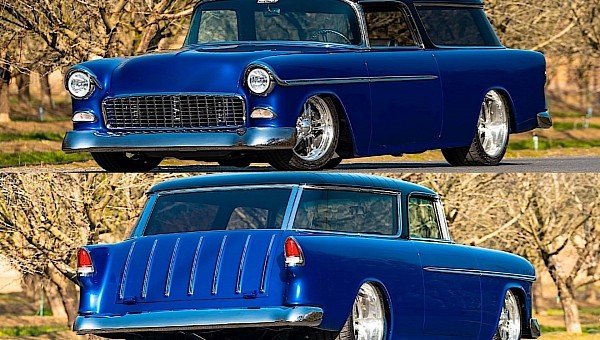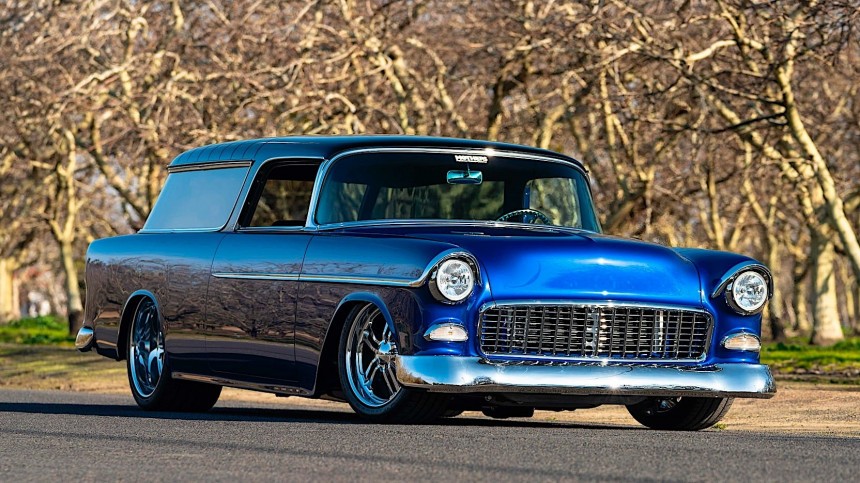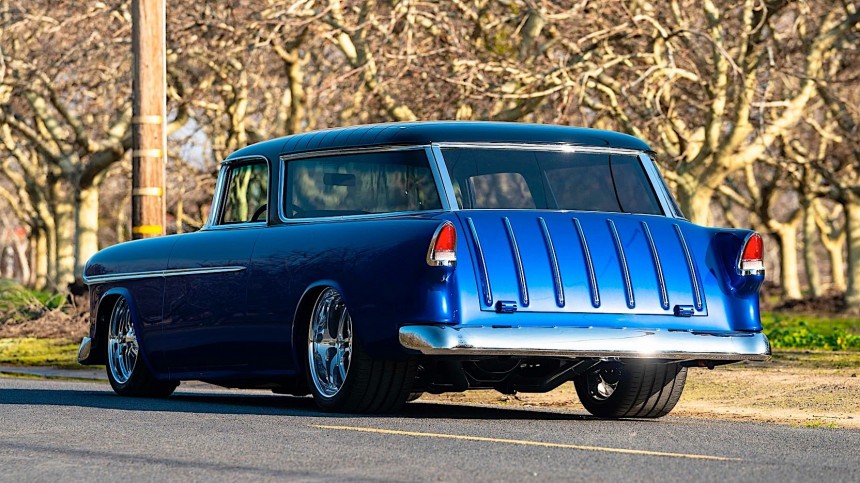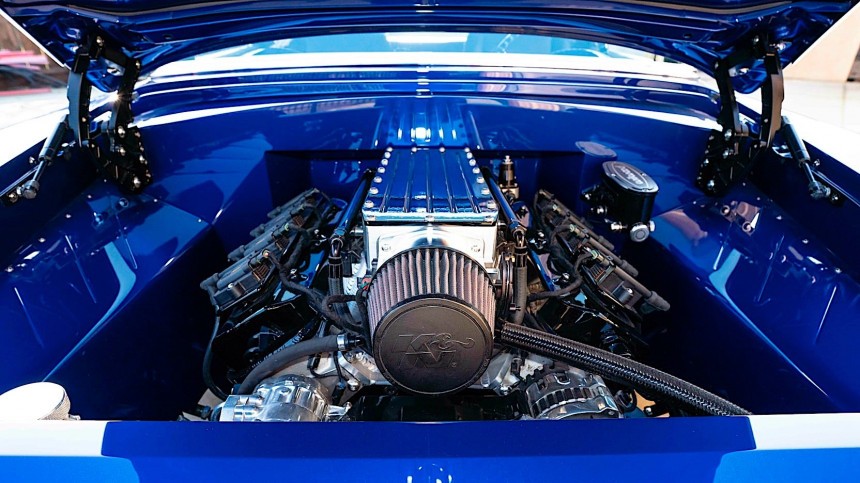We always get excited when we get to see former SEMA show cars surface on the open market. That means someone, somewhere, will get to enjoy these incredible builds far beyond just looking at them in some supplier’s or builder’s stand in Las Vegas. And we’re all for letting cars do what they were always meant to do: drive and enchant.
It usually takes quite a bit of time until a SEMA show car becomes available for whoever is wealthy enough to afford it. In the case of the blue contraption we have here, that’s not the case, as just a few months have passed since it first surfaced: it appeared on the grounds of the Las Vegas event in 2022, and already made its way to an auction block.
The car is a Chevrolet Nomad. That’s the nameplate the bowtie carmaker invented in 1955 to designate some of the most luxurious interpretations of a type of design we no longer get to see these days: a two-door station wagon.
The Nomad was in its day the top-of-the-line offering in the pack of models that would go down in history as the Tri-Five cars. That would be, aside for the Nomad itself, the 150, 210 and the Bel Air.
Little did Chevy know at the time that this range of vehicles would go on to haunt the dreams of the passionate and empty their bank accounts long after production had ended. All of the cars in the Tri-Five series are highly appreciated by customizers and collectors, and are sights to remember for the rest of us every time they come under the spotlight.
The Nomad itself was not around for that long. The first official run lasted for just six years, from 1955 to 1961, with a comeback of the nameplate recorded by the history books between 1968 and 1972. The second time it was used for a car in the Chevelle range. Ironically, by then it had gone from being a name of a top-of-the-range trim to being the cheapest of all Chevelles. A third iteration of the name was then used to represent a van.
The example we’re here to look at today is part of that very first model year, 1955, the one that draws the most attention today. We have no background on the car, but we like to imagine it, like many other vehicles from that era, being saved from inside a barn or from a field somewhere and turned into this amazing custom.
As said, the car was shown last November at SEMA, as part of the display of Mother's Polish, a maker of car-care products. It wasn’t driven all that much since it was made, as the thing’s odometer, lost in a dashboard fitted with Dakota Digital analog gauges, shows just 15 miles (24 km) of drive distance since coming together.
The custom is described as a frame-off build, and it retains all the design elements that have made this breed so cherished over the years: two round headlights (modern LED ones in this case, complete with a blue outer ring), a low and wide radiator grille, two doors, and a low roof. A lot of other things have changed, though.
The Nomad wears a color called Estoril Royal Blue on its body panels, mixed with a black top. It’s perhaps not the most fortunate of color combinations, as it steals some of the appeal the build might have had wearing more potent hues, but it’s not something you can completely ignore either.
The exterior shows no door handles, fuel tank door, or mirrors, and only small traces of shiny chrome can be seen on the windows trim. The day is saved by the very wide and polished wheels, Budnik 20-inch pieces in a five-spoke design, with the rear ones sitting inside wheel arches lowered by one inch. The cherry on the cake is the rear bumper, which was sourced from a Bel Air.
The interior of the Nomad is in black leather all over, contrasted by blue stitching. We see a center console in there, a leather-trimmed steering wheel also made by Budnik and, as a touch of the modern era, an Alpine audio system comprising an amplifier and subwoofer. Driver and passengers are also treated to a navigation system, and of course Bluetooth connectivity.
Not only the visual and comfort traits of the car have been tampered with. The unnamed builders of this ride placed all those bits you can see onto an Art Morrison chassis that rocks adjustable coilover suspension and a Ford 9 inch rear end.
The wheels get their spin from a huge 572ci (9.4-liter) engine, tied to an automatic transmission and breathing through a custom exhaust. We’re not told how much power the engine produces in this configuration, but Chevy presently offers the ZZ572 with either 621 hp (the ZZ572/620) or 727 hp (the ZZ572/720R).
The SEMA custom is going under the hammer at the end of March in Glendale, Arizona, with auction house Mecum tasked with finding a new owner for it. No estimate is made on how much it is expected to fetch, but rest assured we’ll get back to this story and provide you with that crucial piece of information once we learn it.
The car is a Chevrolet Nomad. That’s the nameplate the bowtie carmaker invented in 1955 to designate some of the most luxurious interpretations of a type of design we no longer get to see these days: a two-door station wagon.
The Nomad was in its day the top-of-the-line offering in the pack of models that would go down in history as the Tri-Five cars. That would be, aside for the Nomad itself, the 150, 210 and the Bel Air.
Little did Chevy know at the time that this range of vehicles would go on to haunt the dreams of the passionate and empty their bank accounts long after production had ended. All of the cars in the Tri-Five series are highly appreciated by customizers and collectors, and are sights to remember for the rest of us every time they come under the spotlight.
The example we’re here to look at today is part of that very first model year, 1955, the one that draws the most attention today. We have no background on the car, but we like to imagine it, like many other vehicles from that era, being saved from inside a barn or from a field somewhere and turned into this amazing custom.
As said, the car was shown last November at SEMA, as part of the display of Mother's Polish, a maker of car-care products. It wasn’t driven all that much since it was made, as the thing’s odometer, lost in a dashboard fitted with Dakota Digital analog gauges, shows just 15 miles (24 km) of drive distance since coming together.
The custom is described as a frame-off build, and it retains all the design elements that have made this breed so cherished over the years: two round headlights (modern LED ones in this case, complete with a blue outer ring), a low and wide radiator grille, two doors, and a low roof. A lot of other things have changed, though.
The exterior shows no door handles, fuel tank door, or mirrors, and only small traces of shiny chrome can be seen on the windows trim. The day is saved by the very wide and polished wheels, Budnik 20-inch pieces in a five-spoke design, with the rear ones sitting inside wheel arches lowered by one inch. The cherry on the cake is the rear bumper, which was sourced from a Bel Air.
The interior of the Nomad is in black leather all over, contrasted by blue stitching. We see a center console in there, a leather-trimmed steering wheel also made by Budnik and, as a touch of the modern era, an Alpine audio system comprising an amplifier and subwoofer. Driver and passengers are also treated to a navigation system, and of course Bluetooth connectivity.
Not only the visual and comfort traits of the car have been tampered with. The unnamed builders of this ride placed all those bits you can see onto an Art Morrison chassis that rocks adjustable coilover suspension and a Ford 9 inch rear end.
The SEMA custom is going under the hammer at the end of March in Glendale, Arizona, with auction house Mecum tasked with finding a new owner for it. No estimate is made on how much it is expected to fetch, but rest assured we’ll get back to this story and provide you with that crucial piece of information once we learn it.

























